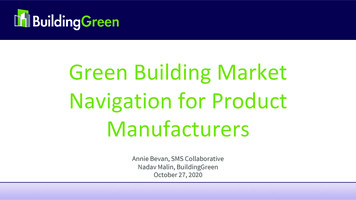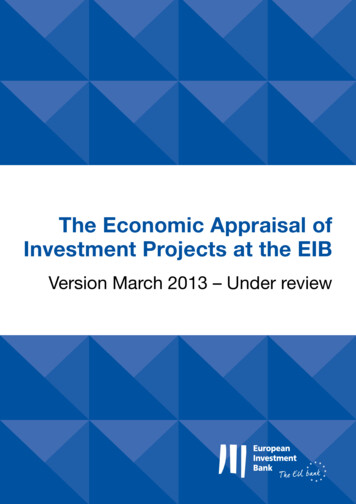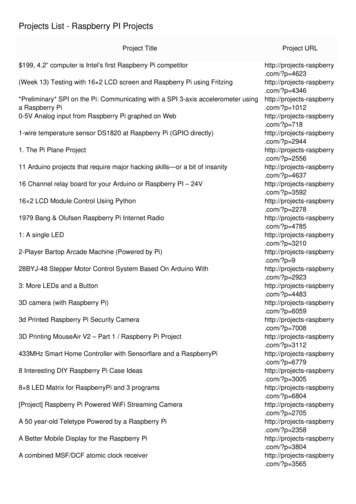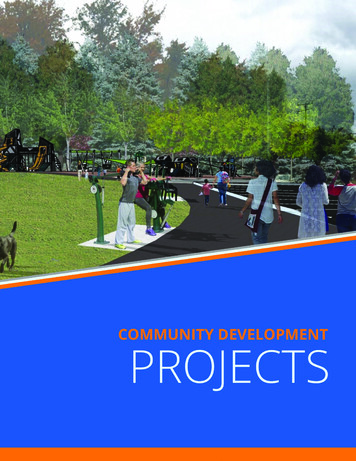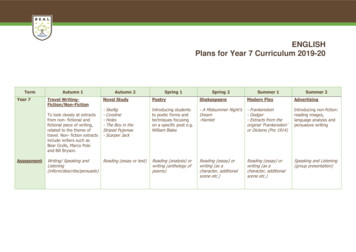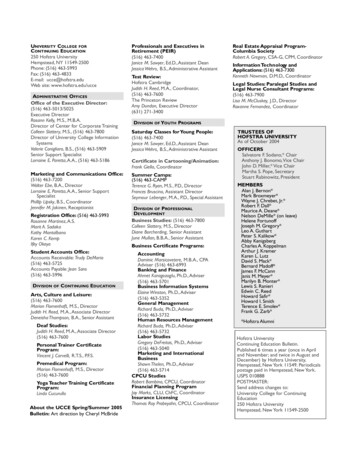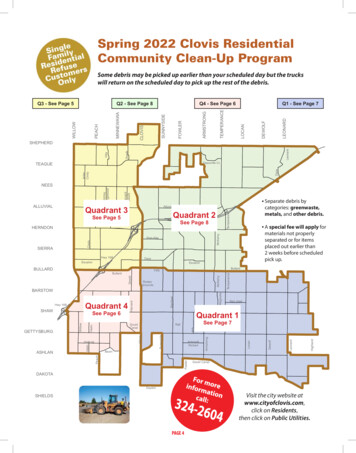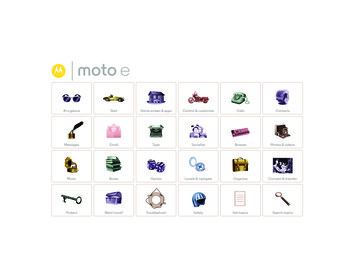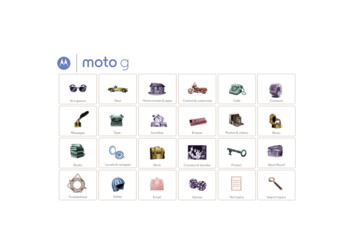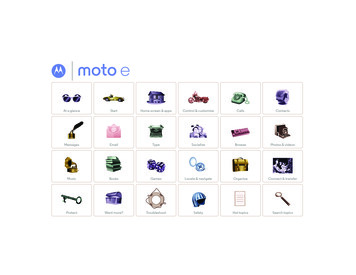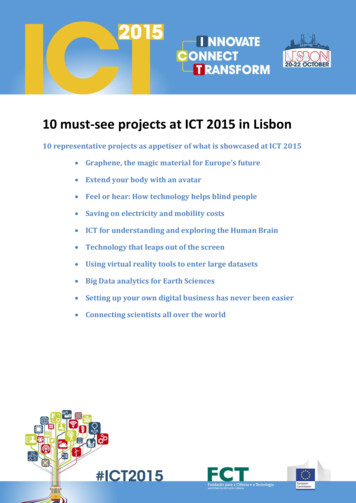
Transcription
10 must-see projects at ICT 2015 in Lisbon10 representative projects as appetiser of what is showcased at ICT 2015 Graphene, the magic material for Europe's future Extend your body with an avatar Feel or hear: How technology helps blind people Saving on electricity and mobility costs ICT for understanding and exploring the Human Brain Technology that leaps out of the screen Using virtual reality tools to enter large datasets Big Data analytics for Earth Sciences Setting up your own digital business has never been easier Connecting scientists all over the world
Graphene, the magic material for Europe's futureExtremely fast charging batteries, new light systems, flexible displays and touch-screens, water filters– these are just some of the possible uses of Graphene, a revolutionary, almost magic new material.It is set to play an important role also in the automotive, aerospace, photonics and electronicsindustry, in the medical world and in many other sectors.Graphene possesses an extraordinary combination of physical and technical properties: it is thethinnest material, it conducts electricity, it is stronger than steel and entails unique opticalproperties. The project investigates and exploits the unique properties of this revolutionary carbonbased material. Thanks to groundbreaking experiments in Graphene, Sir Kostya Novoselov, invitedspeaker in the plenary session of the ICT 2015 conference, has been awarded the Nobel Prize inPhysics jointly with Andre Geim.The Graphene project is, along with the Human Brain Project (also showcasing at ICT 2015), the firstof the European Commission's Future and Emerging Technology Flagships, whose mission is toaddress the big scientific and technological challenges through long-term, multidisciplinary research.The Graphene booth can be found in the Off-site of ICT 2015 at Praça do Comércio."Introducing Mr G" (Animation about Graphene)***Extend your body with an avatarImagine mentally sending a robot exploring a remote place, while you're still sitting in front of yourcomputer. You simply operate your “avatar” thinking where you want it to go, seeing what the avatarsees, experiencing the place without being physically there. This will soon become possible thanks to"embodiment" technologies. The technology works via a Brain-Computer Interface (BCI): the sensorsystem detects your brain activity and transmits the signals to the avatar, which then acts accordingto your "orders". The full embodiment experience is granted by special glasses transmitting, in realtime, the images captured by the avatar video. This technique could help disabled patients byrestoring some of their functions: they will be able to move humanoid robots or only parts of them(e.g. arms) via a BCI, and use the avatar to perform everyday works for them. Prototypes have beenpartly developed within the EU-funded project VERE.The same concept also works the other way round: by stimulating patients (through a visual orhearing stimulus or by touch), it is possible to map the active brain regions. This is critical for somepatients with epilepsy (intractable seizure disorders) or brain tumours, as it complements availabletechniques to localise precisely the affected areas. It allows surgeons to protect, during surgery,essential brain regions (like primary motor and sensory cortex, as well as brain areas supportinglanguage and memory functions) to avoid neurological deficits. The software system (CortiQ) isalready on the market and used in clinical trials (in Japan and US) replacing electrical stimulation,with the advantage of less secondary effects to the patients.Booth C14 in the Connect Area (hall 1) at ICT 2015Press contact: Dr. Günter Edlinger, edlinger@gtec.at, phone: 43-676-9442860Euronews video about VERE prototype (until 2:50)Video CortiQPage 2 of 7
***Feel or hear: How technology helps blind peopleMaking life a little bit easier for blind and visually impaired people is the core drive of two EU-fundedresearch projects: Blindpad and ABBI. Blindpad (Personal Assistive Device for the BLIND) makesgraphical content (such as tactile maps or drawings) accessible by the sense of touch. ABBI (AudioBracelet for Blind Interactions) builds an audio bracelet for blind children that will provide spatialinformation on where and how movement around them occurs.Blindpad will produce a device that will look like a tablet PC. Its surface, however, will not remainsmooth and flat. Parts of it can be lowered or raised just enough for someone touching it to feel thedifference, thus "displaying" a line, a dot, an arrow or other symbols or geometric shapes. Bytouching it, visually impaired people can understand maps or graphical symbols and get informationabout their surroundings, for example the location of a door. Thanks to Blindpad a visually impairedchild could share a classroom with sighted students (while the latter observe the teacher tracing asymbol on the blackboard, their visually impaired classmate could also follow the course from his/herdesk) or it could help blind people find their way around a room, a building or a city, by allowingthem to develop a mental map of their surroundings.While Blindpad uses touch, ABBI works with sounds and with children!. The child wears the device onthe wrist or feet. As the child moves, the bracelet emits different beeping sounds, depending on thedifferent movements the child makes. This helps the child build a representation of his/hermovement in space. Such sound sources could also be placed on other persons or objects to providea better sense of the events taking place in the environment and to improve the mobility and socialskills of these children and adults. This way the audio bracelet helps visually impaired childrenposition themselves, find their orientation, and coordinate their movements, thus supporting theirmobility and social skills.Booth C16 in the Connect Area (hall 1) at ICT 2015 (joint stand under the title "Tech for VIPs")Blindpad at Festival of Science (video, Italian language)Blindpad article on the iit-website (also available in Italian)***Saving on electricity and mobility costsYou've heard of using renewable energies at home to preserve the environment but also to cut yourbills. How about using them to also cut your mobility or transport costs?FREE-MOBY could help you do that. The project uses photovoltaic installations not only to provideelectricity to home appliances, but also to charge a plugged-in vehicle, while selling excess energy tothe grid. This whole system is controlled remotely by a smart phone. The results are: a lower homeenergy bill – because of the use of stored energy in a battery rack during peak hours – plus loweroperation costs of the electric vehicle – because it is charged by renewable energy produced byphotovoltaic panels installed on the roof of a house. Additionally, the vehicle also uses energyproduced by smart photovoltaic panels integrated in its body.Page 3 of 7
The vision is that the types of electric vehicles proposed and the bidirectional energy routingbetween vehicles and homes will motivate a rapid deployment of safe, securely connected, lowpriced electric vehicles and a further impulse to install integrated photovoltaic-battery systems inhouses across the EU. Free-Moby continues an effort that started with the P-MOB project.Booth C23 in the Connect Area (hall 1) of ICT 2015Press contact: Pietro Perlo, phone: 39 3357199243***ICT for understanding and exploring the Human BrainUnderstanding the human brain is one of the greatest challenges facing 21st century science. Theproject was launched in October 2013 will last for ten years with a support of 1 billion as one of thetwo flagship initiatives in Future and Emerging Technologies.The goal of the Human Brain Project is to better understand the human brain and its diseases, usinginformation and communication technology (ICT) as a catalyst for a global collaborative effort. It isabout modelling and simulating the brain using supercomputers. HBP will deliver revolutionarycomputing technologies mimicking the brain with its power, fault-tolerance and consumptionefficiency. HBP is designed as an open, big data integrator project rather than a project producingmore data. Therefore the focus is on using the very large corpus of neurophysiological data that aredormant in data repositories and to exploit them to build the model. To achieve its ambitious goals,the HBP brings together many different scientific communities: from neuroscience and medicine tomathematics, computer science, high performance computing and robotics.What sets the HBP apart from existing scientific approaches in understanding the human brain is thatit is developing an ICT infrastructure in order to build brain computer models. The HBP ICTinfrastructure will be open to all relevant scientific communities to make progress in neuroscience,computing and medicine.Booth i08 in the Innovate Area (hall 2) at ICT 2015Video presentation***Technology that leaps out of the screenImagine pulling objects and data out of the screen of your smartphone or laptop and handling themas any other object around you: that is the vision of GHOST (Generic, Highly-Organic Shape-ChangingInterfaces), project, designed to revolutionise user interaction with technology as it allows us tohandle objects, and even data, in a completely new way.GHOST adds 3D dimension to our flat screens to allow us perceiving and manipulating data. It thusdoes not just display holograms, but shows, for example, real bar charts that can be pulled, pushedor re-ordered; in the future, we could even be pulling hills and valleys out of a map. This would allowa surgeon, for instance, to work on a virtual brain physically, with the full tactile experience, beforeperforming a real-life operation. Designers and artists using physical proxies such as clay can mouldand remould objects and store them in the computer as they work.Page 4 of 7
GHOST has produced prototypes to showcase shape-changing applications. ‘Emerge’ is one suchprototype which allows data in bar charts to be pulled out of the screen by fingertips. Theinformation, whether it’s election results or rainfall patterns, can then be re-ordered and brokendown by column, row or individually, in order to visualise it better.The researchers have also been working with ‘morphees’, that is flexible mobile devices with lycra oralloy displays which bend and stretch according to use. These can change shape automatically toform screens to shield your fingers when you type in a PIN code, for example, or to move the displayto the twists and turns of a game. And such devices can be enlarged by the hand to examine datacloser and shrunk again for storing away in a case or pocket.The project is confident that displays which change shape as you use them are probably only fiveyears off now.Booth i11 in the Innovate Area (hall 2) at ICT 2015Press contact: John Tiab, Copenhagen University, john.tiab@di.ku.dk, phone 4581946750VideosDeformable screens that change shapeTowards rapid prototyping with shape-changing displays for designersPioneering 3D touch screens (BBC video)***Using virtual reality tools to enter large datasetsIn our digital societies, we generate more and more data. Whether it relates to geographicalinformation, weather, research, transport, energy consumption, or health, data collection is easy. Buthow to make sense of all these big and complex datasets?Researchers from the CEEDs project believe there may be help at hand in evaluating big data from anunlikely source: our subconscious. We are aware of about only 10% of our brain activity; CEEDsresearchers have been looking at ways to increase that percentage, so we can perform better in ourenvironment, overwhelmed by data. They built an immersive 3D room, the CEEDs eXperienceInduction Machine (XIM), which uses virtual reality tools and sensors, to make the subconscious‘visible’ and allow the user to "see" and establish relationships within large datasets. The XIMinfrastructure was combined with the latest generation hardware and immersive VR technologies inBrainX3. Employing a range of visual, audio and tactile sensor systems, it also monitors users’reaction to the experience to find out what they focus on and how they do it.Possible applications range from inspection of satellite imagery and oil prospecting, to astronomy,economics and historical research. Future development of CEEDs might also go over big data; it couldhelp with gathering feedback from users in physical environments such as museums, libraries, shops,concerts, training classes etc.CEEDs also studies applications immersing users into historical contexts. For example, the CEEDs’Holocaust Memorial installation provides an interactive narrative structure that represents keyaspects of the holocaust, including its archaeological, social, cultural, psychological, and medicalaspects. The objective here is to help users understand the importance of the holocaust.Page 5 of 7
Booth i12 in the Innovate Area (hall 2) at ICT 2015Press contact: Jonathan Freeman, jonny.freeman@gmail.com, phone: 447973776750Project websiteProject story (in 6 languages)Video: Beyond the subconsciousVideo: Deep inside our subconscious***Big Data analytics for Earth SciencesHuge data sets are generated by the study of the earth, whether it's geology, oceanography orastronomy. But how do you make sure that this data is not just lost or sitting in an archive? TheEarthServer project is there to push the boundaries of Big Earth Data processing by allowingresearchers to easily access and analyse multi-dimensional data from a wide range of sources.EarthServer has established services and technology that gather Earth science data such as satelliteimages, aerial imagery (e.g. from aircrafts) or weather data. The sources can be multiple, such asairplanes equipped with cameras and satellites equipped with sensors or imagers. The data is madeavailable to everyone through a single source, using a peer network of data centres worldwide.EarthServer gathers all the data and then sorts it. A concrete result is that it would allow thehistorian of the future to easily find what the weather conditions were, how strong were the windsand sea currents in, for example, Le Havre on any given date.EarthServer is using NASA’s World Wind 3-D engine that allows users to zoom in from satellitealtitude to any spot on Earth. The operational services on Earth Observation imagery, weather data,and Mars data will be demonstrated live at the booth.There's a lot to gain from such large-scale data access and data sorting capability: for example, usinglong term Earth Observation monitoring (such as Landsat) could help us see how a place on Earthchanged in the past several decades and to what extent. EarthServer could benefit severalorganisations and sectors ranging from Earth Observation in the broadest sense, climate andweather modelling, marine/ocean science and even the study of solar system bodies other thanEarth. Last, but not least, all of us could use EarthServer to extract space- and time-variable weatherinformation for our own, customized automatic weather forecasts to help us plan our day.Booth T14 in the Transform Area (hall 2) of ICT 2015Project websiteMore info on the technology powering EarthServer-2***Setting up your own digital business has never been easierFIWARE helps new digital business ideas come to life by making available a set of components thatanyone can use to help turn their ideas into concrete solutions. Besides components, FIWARE comeswith an innovation ecosystem formed by application developers, platform technology providers,startups and big companies, and organisations that make open data available. Building applicationsbecomes then quicker, easier and cheaper, especially for start-ups and SMEs which can make use ofPage 6 of 7
pre-fabricated components and access to open data, e.g. from cities. For example, Smartaxi, a mobileapp helping taxi-drivers better meet demand, and FoodLoop, an app helping you find the best foodoffers around you, were developed with the use of tools provided by FIWARE.FIWARE comes with an accelerator programme that promotes the take-up of FIWARE technologiesamong system integrators and application developers, with special focus on SMEs and startups.There are 16 accelerator projects providing support, e.g. mentoring, and training to startups andSMEs. Some examples of projects supported by the accelerator programme: TobyRich, developingsmartphone controlled planes; Guide Me Right, developing an application that lets guests/touristsfind local friends to show them around in the friends’ city or region; 8fit, a mobile fitness app.Booth T17 in the Transform Area (hall 2) of ICT 2015Project website, see also The Future Internet Public-Private Partnership (PPP)***Connecting scientists all over the worldThe GÉANT network is a vital element of Europe’s e-infrastructure strategy interconnecting Europe’snational research and education networks (NRENs). It operates at speeds of up to 500Gbps, reaches50m users in 10,000 institutions in Europe, and a total of 100 countries worldwide. The project waseven included in the Guinness World Record for fastest provisioning of long haul optical transmissioncapacity (July 2013)!GÉANT connects universities and the world’s largest research projects, allowing researchers andinnovators to share data, discuss and learn together, and test their innovations across the network,thus helping deliver real societal benefits. Some of Europe's greatest research wouldn't have takenplace had it not been for GÉANT: research in particle physics (CERN’s Large Hadron Collider), earthobservation (EUMETSAT and Copernicus), radio astronomy (NEXPRES, and the in-planning SquareKilometre Array-SKA), Bioinformatics (EMBL-EBI) and medical & health (DECIDE, ITHANET).From big science projects to the man in the street, the knowledge communities GÉANT servelibraries, museums, and hospitals with connectivity. At ICT2015 GÉANT will be showcasing MDPAEDIGREE and CARDIOPROOF. These 2 projects are about to create the first Big Data and ModelDriven decision support system for paediatrics, connecting 7 hospitals across Europe. The project willalso present a study on data sonification in cancer diagnosis: taking a biopsy is invasive and resultscan take weeks; research is underway into the use of audio devices for immediate diagnosis.Booth EV5 in the EC Village (hall 2) at ICT 2015Project website current project phase (GN4-1) – projects under Horizon 2020Previous project website previous project phase (GN3plus) – projects under FP7 until 30 April 2015Page 7 of 7
10 must-see projects at ICT 2015 in Lisbon 10 representative projects as appetiser of what is showcased at ICT 2015 Graphene, the magic material for Europe's future Extend your body with an avatar Feel or hear: How technology helps blind people Saving on electricity and mobility costs ICT for understanding and exploring the Human Brain
